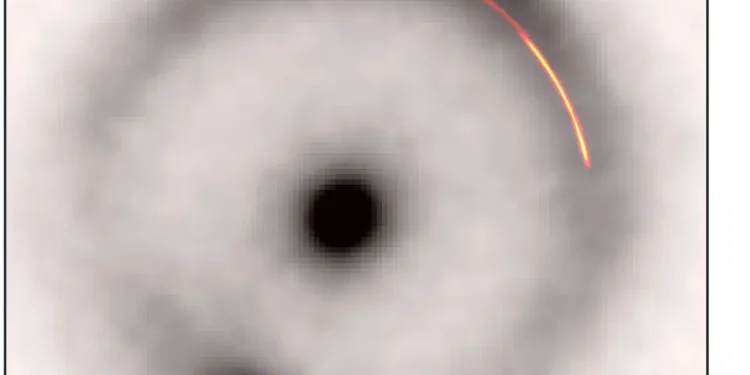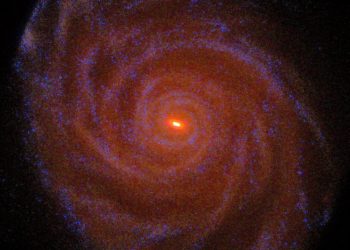For decades, astronomers have been searching for something they can’t see. They call it dark matter, an invisible substance that is estimated to make up most of the mass of the universe, sculpting galaxies and clusters with its gravity. Now researchers say they have spotted the smallest cluster of dark matter ever detected, a million times more massive than the Sun and yet entirely dark.
The discovery, described in Natural astronomy by Devon Powell of the Max Planck Institute for Astrophysics and colleagues, happened almost by accident. The team was observing an extraordinary Einstein ring, a near-perfect circle of light created when a massive galaxy in the foreground distorts the light of a distant galaxy behind it. “Searching for dark objects that don’t appear to emit any light is clearly a challenge,” Powell said in a statement.
What they found was a small notch in this ring of light.
Dark Distortion in the Arc
The team was studying a radio source known as JVAS B1938+666, located about 10 billion light years away. A supermassive black hole powers this young radio galaxy, known as a compact symmetric object, or CSO. Like another article in Monthly Notices of the Royal Astronomical Society details, its light forms an extremely fine gravitational arc, one of the sharpest ever observed.
But as astronomers mapped the arc in exquisite detail, combining radio telescopes across the planet, they noticed something strange. Part of the arc seemed distorted, as if someone had pinched the light itself.
To determine the cause of this disturbance, Powell’s team used a powerful computing technique called gravitational imaging. Essentially, they built a map of gravity shaping the arc, pixel by pixel, on supercomputers. When they compared their models with and without the mystery object, one version fit the data much better.
Without the extra mass, the simulated ring had an obvious flaw: a discontinuity in the light. With this, the arc smoothed out perfectly. “It’s an impressive achievement to detect such a low-mass object at such a great distance from us,” said co-author Chris Fassnacht of the University of California, Davis. The mass of the object: about 1.13 million Suns, contained in a region only 80 parsecs wide.
The invisible tuft

Nothing in the newly discovered object emits light, including radio, optical or infrared wavelengths. This leaves two possibilities. It could be an ultracompact, inactive dwarf galaxy or something even more intriguing: a pure cluster of dark matter, the smallest ever seen by a factor of 100.
“Given the sensitivity of our data, we expected to find at least one dark object,” Powell said. “Our discovery is therefore consistent with the so-called cold dark matter theory on which much of our understanding of galaxy formation is based.”
This theory, known as ΛCDM (Lambda Cold Dark Matter), has guided cosmology for decades. It posits that the universe is dominated by a cosmological constant (Λ) and “cold” dark matter – invisible, slow-moving particles that cluster together under the influence of gravity. If these particles were “hot”, moving at close to the speed of light, they would spread out the small structures, preventing the formation of tiny clusters like this. The simple existence of this object therefore supports the idea that dark matter can indeed group together at smaller scales.
What could it be?
If it really is a dark matter cluster, it fits perfectly with the expectations of cold dark matter models. In fact, simulations suggest that galaxies like the Milky Way should be riddled with such subhaloes, that is, millions of invisible clusters orbiting within their halos. However, astronomers had never seen one on such a small scale until now.
Interestingly, the team notes that the cluster’s density could be higher than typical predictions from dark matter simulations. This is reinforced by similar results for other small disruptors discovered using lensing, raising the question of whether these halos are more compact than theory suggests.
For now, Powell and his colleagues are cautious. The nature of the object remains uncertain until astronomers can search deeper for any traces of starlight or other emissions. “A more definitive statement about what type of object this is will require extensive optical or infrared observations,” the team writes. This will be a challenge, given the brilliant glare of the lensed galaxy behind it.
This is the first time that such a small and distant object has been discovered using only its gravitational pull. This opens up a new way of studying the universe by mapping the invisible structure that holds it in place.
“This is the lowest mass object we know, by two orders of magnitude, that can be detected at a cosmological distance by its gravitational effect,” the authors wrote. “Finding low-mass objects like this is key to learning more about the nature of dark matter,” Fassnacht added, according to Cosmos Review.
As telescopes become more sensitive, astronomers hope to spot dozens, or even hundreds, of additional “pinches” in the luminous fabric. Each could help answer the universe’s most elusive question: What exactly is the dark matter that binds everything?









